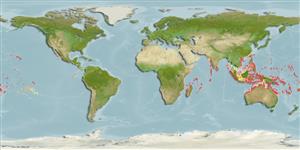Common names from other countries
Environment: milieu / climate zone / depth range / distribution range
Ecologia
marinhas associadas(os) a recifes; intervalo de profundidade 1 - 30 m (Ref. 58302), usually 2 - 10 m (Ref. 89972). Tropical; 25°N - 24°S
Indo-Pacific: Chagos Islands and Reunion (Ref. 53568), to Panama, north to Japan and the Hawaiian Islands, south to Tonga and Mangaréva.
Tamanho / Peso / Idade
Maturity: Lm ? range ? - ? cm
Max length : 250 cm TL macho/indeterminado; (Ref. 30874)
Espinhos dorsais (total) : 0; Raios dorsais moles (total) : 0; Espinhos anais: 0; Raios anais moles: 0; Vértebras: 141 - 147. Each posterior nostril which is located in front of, and above the eye, is large and surrounded by a fleshy rim, and each anterior nostril bears a bilobed fleshy protuberance which is absent in species of Enchelycore.
Inhabits areas with strong surge such as benches, outer reef flats and reef fronts (Ref. 9710). Benthic (Ref. 58302). Very secretive during the day; feeds on fishes and octopi at night (Ref. 9710). May bite by accident or when provoked.
Life cycle and mating behavior
Maturities | Reprodução | Spawnings | Egg(s) | Fecundities | Larvas
Myers, R.F., 1991. Micronesian reef fishes. Second Ed. Coral Graphics, Barrigada, Guam. 298 p. (Ref. 1602)
Categoria na Lista Vermelha da IUCN (Ref. 130435)
CITES (Ref. 128078)
Not Evaluated
Ameaça para o homem
Traumatogenic (Ref. 2334)
Utilização humana
Ferramentas
Relatórios especiais
Descarregue XML
Fontes da internet
Estimates based on models
Preferred temperature (Ref.
115969): 25.3 - 29.3, mean 28.4 (based on 2558 cells).
Phylogenetic diversity index (Ref.
82804): PD
50 = 1.0000 [Uniqueness, from 0.5 = low to 2.0 = high].
Bayesian length-weight: a=0.00050 (0.00025 - 0.00101), b=3.26 (3.10 - 3.42), in cm Total Length, based on LWR estimates for this (Sub)family-body shape (Ref.
93245).
Nível Trófico (Ref.
69278): 4.5 ±0.67 se; based on food items.
Resiliência (Ref.
120179): Muito baixo, tempo mínimo de duplicação da população maior que 14 anos (Preliminary K or Fecundity.).
Fishing Vulnerability (Ref.
59153): Very high vulnerability (90 of 100).
